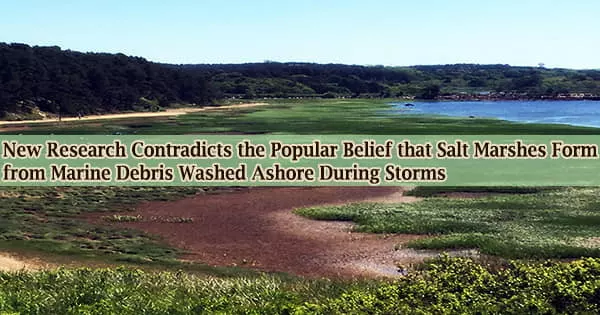New research undertaken by the University of Massachusetts Amherst into the life and times of a salt marsh in New England substantially alters our understanding of how salt marshes obtain the silt that keeps them alive.
This study, which was just published in the Journal of Geophysical Research: Earth Surface, has broad implications for managing New England’s shoreline as it grapples with development, sea-level rise, and other environmental concerns.
Salt marshes are vital because they protect against erosion and flooding, sequester carbon, provide habitat for juvenile species and migratory birds, and filter pollutants and excess nutrients. However, a marsh can only survive if its surface is high enough above sea level to drain at low tide, which means that marshes must import mineral sediment to grow volume and survive.
For decades, the accepted idea of how a salt marsh formed was that when a river wound its way to the sea, it took up material as it passed through hill and field on its journey to the sea.
When the river reached the coast, it slowed and dumped its sediment load, which salt marshes absorbed and grew upon overtime to develop salt marsh platforms at river and stream mouths across New England. The only issue with this model is that it may not accurately reflect how New England’s salt marshes function.
“We’ve been looking in the wrong direction,” says Jon Woodruff, professor of geosciences at UMass Amherst and one of the paper’s co-authors. “These sediments are mostly coming from the ocean, not rivers.”
“If we’re going to manage and protect salt marshes efficiently and effectively, we need to know where their sediment comes from,” says Hannah Baranes, the paper’s lead author and a postdoctoral researcher at the Gulf of Maine Research Institute (GMRI) who completed this research as part of her Ph.D. in geosciences at UMass.
“But a great deal of previous work has focused on large, complex marsh systems, which has made it difficult to pinpoint where exactly sediment comes from.”
Salt marshes are expensive to protect, and we have limited resources to figure out this problem. We need to understand any natural process that can help us out.
Hannah Baranes
The North/South River estuary, a typical New England salt marsh system near Marshfield, Massachusetts, was the subject of Baranes and her colleagues’ research. They used a combination of long, medium, and short-term experiments, which included extracting sediment cores to document the marsh’s 200-year history and placing devices in the channel and on the marsh’s surface to measure sediment transport and deposition in real-time.
It was dirty work: “we had to navigate these salt marshes on foot and figure out how to get our equipment in and out while wading through waist-deep mud in all seasons,” says Baranes.
There were also mosquitoes and other insects to contend with. Don’t get Baranes started on the crabs that got caught in some of the sediment traps.
Baranes and her colleagues, including UMass Amherst undergraduates, were able to piece together an unparalleled glimpse into the life of salt marshes in New England over the period of two years.
The great bulk of sediment is supplied by the sea during storms that hammer the coast, it turns out. This has significant consequences for the health of the coasts of New England.
“Salt marshes are expensive to protect and we have limited resources to figure out this problem,” says Baranes. “We need to understand any natural process that can help us out.”
Furthermore, as Woodruff points out, beaches and marshes are intertwined systems, and any effort to safeguard beaches from erosion might have unintended consequences for the health of the salt marshes.
Unfortunately, there has been very little study done to date to do so, so we don’t know what unintended repercussions “coastal armoring,” such as the construction of sea walls, jetties, and other structures, might have on nearby salt marshes.
Both academics want to learn more about how salt marshes interact with other coastal characteristics like Maine’s cliffs and Massachusetts’ beaches. The project, which was supported by the DOI/USGS Northeast Climate Adaptation Science Center, benefited greatly from the efforts of UMass Amherst undergraduates.
“This has been a fantastic opportunity to bring undergrads into the project and show them what actual in-the-field science research looks like,” says Baranes, and Woodruff agrees. “We always have students who grew up on the coast, and they love bringing that personal history to their scientific research.”
















